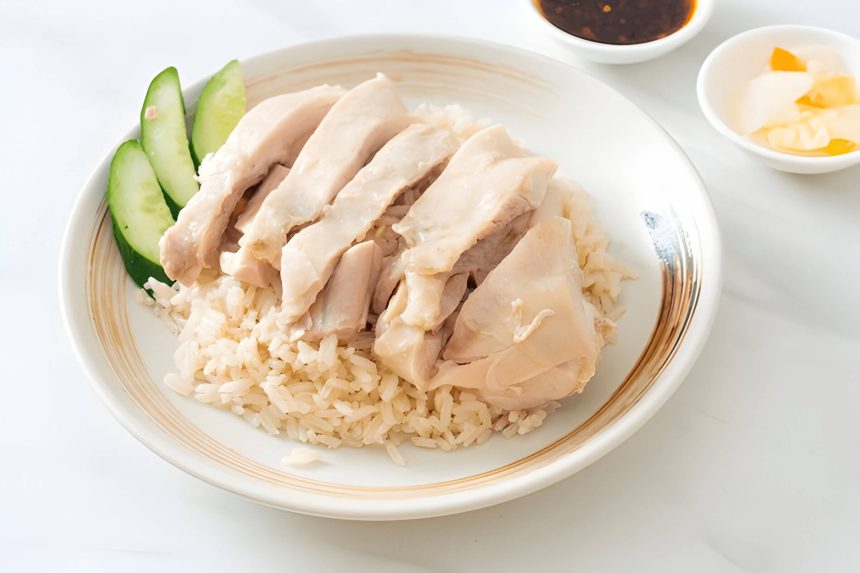The Chicken and Rice Diet, known for its simplicity and high protein content, combines lean chicken with rice. While supporters claim benefits like weight management and muscle growth, its restrictive nature raises concerns about nutritional balance and long-term viability. This article examines the diet’s potential benefits, risks, and practical aspects to help readers make informed nutritional decisions.
What is the Chicken and Rice Diet?
The Chicken and Rice Diet is a straightforward and simple diet plan that focuses on consuming primarily chicken and rice as the main components of meals. This diet is based on the principle of consuming lean protein and complex carbohydrates while minimizing fat intake. The combination of chicken, a lean protein source, and rice, a complex carbohydrate, provides a balanced nutritional profile that can support weight loss and muscle maintenance.
This low-fat meal plan typically involves eating measured portions of grilled or baked chicken breast paired with brown or white rice. The diet’s simplicity makes it easy to follow and prepare meals, which can be beneficial for those with busy lifestyles or those new to structured eating plans. While the Chicken and Rice Diet can be effective for short-term weight loss goals, it’s important to note that it may lack variety and certain essential nutrients if followed for extended periods without proper supplementation or the inclusion of other foods.
Proponents of this diet appreciate its straightforward approach and the potential for quick results. However, nutritionists often recommend incorporating a wider variety of foods to ensure a more comprehensive nutrient intake and to maintain long-term dietary adherence.
Nutritional Profile of Chicken and Rice
Chicken and rice is a popular meal combination that offers a balanced nutritional profile. Chicken is an excellent source of lean protein, providing approximately 31 grams per 100-gram serving of cooked breast meat. This protein is essential for muscle growth, repair, and overall body function. Rice, on the other hand, is primarily composed of carbohydrates, supplying about 28 grams per 100-gram serving of cooked white rice. These carbohydrates serve as the body’s main energy source.
In terms of calorie count, a typical serving of chicken and rice (100 grams each) contains around 335 calories, making it a moderate-calorie meal option. The macronutrient breakdown is well-balanced, with protein from the chicken and carbohydrates from the rice.
Both ingredients also offer various essential nutrients. Chicken is rich in B vitamins, particularly niacin and vitamin B6, which are crucial for energy metabolism and brain function. It also contains minerals like selenium and phosphorus. Rice provides additional B vitamins, particularly thiamin and folate, as well as small amounts of iron and magnesium.
It’s worth noting that brown rice offers more fiber and micronutrients compared to white rice, potentially enhancing the overall nutritional value of the meal. By combining chicken and rice, you create a meal that provides a good balance of macronutrients and various essential nutrients, supporting overall health and energy needs.
Potential Benefits of a Chicken and Rice Diet
A chicken and rice diet offers several potential benefits for those looking to improve their health and fitness. Firstly, this combination can be an effective tool for weight loss due to its high protein content and relatively low calorie density. The lean protein in chicken helps promote satiety, while rice provides complex carbohydrates for sustained energy.
For muscle building enthusiasts, the chicken and rice diet is a staple. The high-quality protein in chicken supports muscle repair and growth, while rice provides the necessary carbohydrates to fuel workouts and aid in recovery. This balanced combination can help optimize muscle gains when paired with an appropriate exercise regimen.
Digestive health may also improve on a chicken and rice diet. Both foods are easily digestible and gentle on the stomach, making this diet particularly beneficial for those with sensitive digestive systems or recovering from gastrointestinal issues.
One of the most appealing aspects of a chicken and rice diet is its simplicity in meal preparation. These ingredients can be cooked in bulk and easily portioned for the week, saving time and reducing the stress of daily meal planning.
Lastly, this diet is notably budget-friendly. Both chicken and rice are relatively inexpensive, widely available, and can be purchased in bulk, making it an accessible option for those looking to eat healthily without breaking the bank.
Risks and Limitations of the Chicken and Rice Diet
The chicken and rice diet, while popular for its simplicity and potential weight loss benefits, comes with several risks and limitations that warrant careful consideration. One primary concern is the risk of nutritional deficiencies. This restrictive diet lacks variety, potentially leading to inadequate intake of essential vitamins, minerals, and fiber. The absence of a wide range of fruits, vegetables, and other food groups can result in imbalanced nutrition over time.
Dietary monotony is another significant drawback. Consuming the same meals repeatedly can lead to boredom and reduced adherence to the diet. This lack of variety not only affects motivation but also limits exposure to diverse nutrients found in a balanced diet.
Sustainability concerns arise when considering the long-term viability of such a restrictive eating plan. Many individuals find it challenging to maintain this diet for extended periods, often resulting in a cycle of weight loss and regain once normal eating patterns resume.
The long-term effects of the chicken and rice diet are not well-studied. Prolonged adherence to this limited diet may impact gut health, metabolism, and overall well-being. It’s crucial to consider the potential consequences on bone density, muscle mass, and organ function when following such a restrictive eating plan for an extended period.
While the chicken and rice diet may offer short-term benefits, it’s essential to approach it with caution and preferably under the guidance of a healthcare professional to mitigate these risks and ensure overall health is not compromised.
How to Implement a Chicken and Rice Diet
Implementing a chicken and rice diet requires careful meal planning and attention to portion sizes. Start by selecting lean chicken cuts and high-quality rice varieties. For optimal nutrition, aim for a balance of 4-6 ounces of cooked chicken and 1/2 to 1 cup of cooked rice per meal, depending on your caloric needs.
Cooking methods play a crucial role in maintaining the diet’s health benefits. Opt for grilling, baking, or steaming chicken to minimize added fats. For rice, consider using a rice cooker or the absorption method for perfectly cooked grains.
To prevent monotony, experiment with flavor variations. Incorporate herbs, spices, and low-sodium seasonings to enhance taste without adding excessive calories. Try different rice types like brown, wild, or basmati for varied textures and nutritional profiles.
Meal timing is essential for sustaining energy levels throughout the day. Plan for 3-4 evenly spaced meals, ensuring a consistent intake of protein and complex carbohydrates. Consider adding vegetables to your meals for added nutrients and fiber.
Complementary Foods to Enhance the Diet
To enhance the nutritional value of a chicken and rice diet, consider incorporating complementary foods. Vegetables are an excellent addition, providing essential vitamins, minerals, and fiber. Dark leafy greens, colorful bell peppers, and cruciferous vegetables like broccoli are particularly beneficial.
Healthy fats are crucial for nutrient absorption and overall health. Include sources such as avocados, olive oil, or nuts to balance your meals. For variety in protein sources, consider adding fish, lean beef, or plant-based options like beans and lentils.
Whole grains can replace white rice occasionally, offering more nutrients and fiber. Options like quinoa, brown rice, or barley can diversify your carbohydrate intake. Additionally, supplements may be necessary to address any nutritional gaps. Consult with a healthcare professional to determine if you need multivitamins, omega-3s, or other specific supplements.
A well-rounded diet is key to optimal health. While chicken and rice provide a good base, incorporating these complementary foods will ensure a more balanced and nutritious eating plan.
Sample Meal Plan for a Week

A chicken and rice diet can be both nutritious and versatile. Here’s a sample meal plan for a week:
Monday:
Breakfast: Brown rice porridge with cinnamon and sliced almonds
Lunch: Grilled chicken breast with steamed broccoli and brown rice
Dinner: Chicken stir-fry with mixed vegetables and white rice
Tuesday:
Breakfast: Scrambled eggs with diced chicken and rice
Lunch: Chicken and rice soup with carrots and celery
Dinner: Baked lemon herb chicken with wild rice pilaf
Wednesday:
Breakfast: Rice cake topped with mashed avocado and shredded chicken
Lunch: Chicken salad with brown rice, cucumber, and tomatoes
Dinner: One-pot chicken and rice casserole with peas
Thursday:
Breakfast: Greek yogurt with rice cereal and berries
Lunch: Chicken wrap with brown rice and lettuce in a whole wheat tortilla
Dinner: Grilled chicken skewers with vegetable rice
Friday:
Breakfast: Rice pudding with cinnamon and diced apple
Lunch: Chicken fried rice with mixed vegetables
Dinner: Roasted chicken thighs with garlic rice and steamed asparagus
Saturday:
Breakfast: Rice and chicken breakfast burrito
Lunch: Cold chicken and rice salad with vinaigrette dressing
Dinner: Slow-cooker chicken and rice with black beans
Sunday:
Breakfast: Chicken sausage with egg-fried rice
Lunch: Leftover chicken and rice soup
Dinner: Teriyaki chicken bowl with brown rice and stir-fried vegetables
Snack suggestions:
Rice cakes with peanut butter, chicken jerky, rice crackers with hummus, or a small portion of leftover chicken and rice.
Meal prep tip:
Cook large batches of rice and chicken at the beginning of the week to save time on busy days.
Who Should Consider the Chicken and Rice Diet?
The chicken and rice diet can be beneficial for various groups of people, each with their own specific goals and needs. Athletes often turn to this diet for its balanced combination of lean protein and complex carbohydrates, which can support muscle recovery and energy levels during intense training periods. Weight loss seekers may find the diet appealing due to its simplicity and potential for calorie control, as both chicken and rice are relatively low in fat when prepared properly.
Bodybuilders frequently incorporate chicken and rice into their meal plans to meet their high protein requirements and fuel their workouts with easily digestible carbohydrates. People with digestive issues might consider this diet as both chicken and rice are generally well-tolerated foods that are less likely to cause gastrointestinal discomfort.
Budget-conscious individuals can benefit from the chicken and rice diet as well, as these ingredients are typically affordable and widely available. Additionally, they can be prepared in bulk, making meal planning and preparation more efficient and cost-effective.
However, it’s important to note that while the chicken and rice diet can be nutritious, it should be supplemented with a variety of fruits and vegetables to ensure a well-rounded intake of vitamins and minerals.
Is the Chicken and Rice Diet Right for You?

The chicken and rice diet can be an effective short-term solution for weight loss and digestive issues. However, it’s important to consider its limitations and potential drawbacks before committing to this eating plan.
While this diet is simple and can provide quick results, it lacks the nutritional diversity necessary for long-term health. The restricted food choices may lead to nutrient deficiencies and could potentially cause boredom, making it challenging to sustain over time.
Before starting any new diet, it’s crucial to consult with a healthcare professional or registered dietitian. They can help you determine if the chicken and rice diet is appropriate for your individual needs and goals, or if a more balanced and sustainable approach would be better suited for you.
